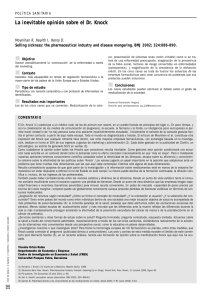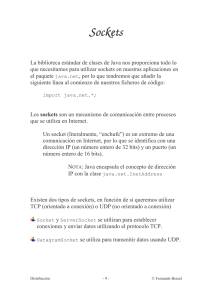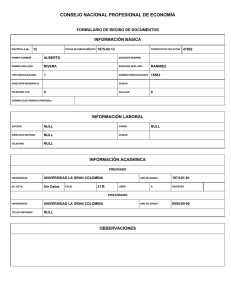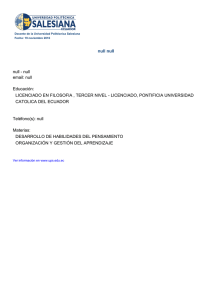cliente-servidor - Pagina del servidor yaqui
Anuncio
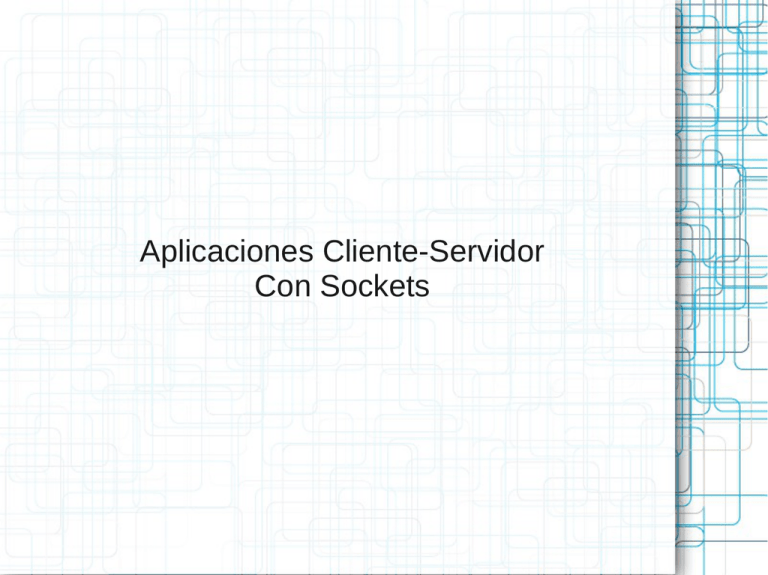
Aplicaciones Cliente-Servidor
Con Sockets
puerto
Cliente
puerto
Escucha
Cliente
puerto
Funcionamiento de
aplicaciones Cliente-Servidor
Cliente
Petición de conexión
125.180.34.10
Puerto
Puerto
Puerto
3012
3000
3011
Servidor
Petición de conexión
Cecilia M. Curlango Rosas
2/15
Lectura y escritura con
sockets
1. Abrir el socket.
2. Abrir un flujo de entrada y uno de salida
al socket.
3. Leer y escribir el flujo siguiendo el
protocolo del servidor.
4. Cerrar los flujos.
5. Cerrar el socket.
Cecilia M. Curlango Rosas
3/15
Antecedente de la Aplicación:
Knock Knock Jokes
●
Server: "Knock knock!"
●
Client: "Who's there?"
●
Server: "Dexter."
●
Client: "Dexter who?"
●
Server: "Dexter halls with boughs of holly."
●
Client: "Groan."
Cecilia Curlango Rosas
4/15
public class KnockKnockServer {
public static void main(String[] args) throws IOException {
ServerSocket serverSocket = null;
try {
serverSocket = new ServerSocket(4444);
} catch (IOException e) {
System.err.println("Could not listen on port: 4444.");
System.exit(1);
}
Socket clientSocket = null;
try {
clientSocket = serverSocket.accept();
} catch (IOException e) {
System.err.println("Accept failed.");
System.exit(1);
}
PrintWriter out = new PrintWriter(clientSocket.getOutputStream(), true);
BufferedReader in = new BufferedReader(
new InputStreamReader(
clientSocket.getInputStream()));
String inputLine, outputLine;
KnockKnockProtocol kkp = new KnockKnockProtocol();
outputLine = kkp.processInput(null);
out.println(outputLine);
while ((inputLine = in.readLine()) != null) {
outputLine = kkp.processInput(inputLine);
out.println(outputLine);
if (outputLine.equals("Bye."))
break;
}
out.close();
in.close();
clientSocket.close();
serverSocket.close();
}
}
Cecilia Curlango Rosas
5/15
Crear el Socket y atarlo al puerto
try {
tryserverSocket
{
= new ServerSocket(4444);
serverSocket
= new
} catch
(IOException
e) {ServerSocket(4444);
} catch
(IOException
e) {
System.out.println("Could
not listen on port: 4444");
System.out.println("Could not listen on port: 4444");
System.exit(-1);
System.exit(-1);
}
}
ServerSocket
public ServerSocket(int port)
throws IOException
Creates a server socket, bound to the specified port. A
port number of 0 means that the port number is
automatically allocated, typically from an ephemeral port
range. This port number can then be retrieved by calling
getLocalPort.
Cecilia Curlango Rosas
6/15
Aceptar conexiones del cliente
Socket clientSocket = null;
Socket
clientSocket = null;
try
{
tryclientSocket
{
= serverSocket.accept();
clientSocket
= serverSocket.accept();
} catch (IOException
e) {
} catch
(IOException
e) {
System.out.println("Accept
failed: 4444");
System.out.println("Accept
failed: 4444");
System.exit(-1);
System.exit(-1);
}
}
●
●
●
Este método espera a que inicie un cliente y solicite una
conexión al host (taranis) y puerto (4444) de este servidor.
Cuando se establece una conexión exitosamente, el
método regresa un nuevo Socket atado al mismo puerto
local y conectado a la dirección y puerto del cliente.
Este nuevo Socket lo utilizará el servidor para comunicarse
con el cliente al mismo tiempo que recibe peticiones de
conexión de otros clientes en el ServerSocket original.
Cecilia Curlango Rosas
7/15
Comunicación con el cliente
PrintWriter out = new PrintWriter(
PrintWriter out = newclientSocket.getOutputStream(),
PrintWriter(
true);
clientSocket.getOutputStream(),
true);
BufferedReader in = new BufferedReader(
BufferedReader in = newnew
BufferedReader(
InputStreamReader(
newclientSocket.getInputStream()));
InputStreamReader(
String inputLine, outputLine; clientSocket.getInputStream()));
String inputLine, outputLine;
// initiate conversation with client
// initiate conversation
with
client
KnockKnockProtocol
kkp = new
KnockKnockProtocol();
KnockKnockProtocol
kkp
=
new
KnockKnockProtocol();
outputLine = kkp.processInput(null);
outputLine = kkp.processInput(null);
out.println(outputLine);
out.println(outputLine);
while ((inputLine = in.readLine()) != null) {
while
((inputLine
= in.readLine()) != null) {
outputLine
= kkp.processInput(inputLine);
outputLine = kkp.processInput(inputLine);
out.println(outputLine);
ifout.println(outputLine);
(outputLine.equals("Bye."))
if break;
(outputLine.equals("Bye."))
break;
}
}
1. Obtener los flujos de entrada al socket y crear objetos para leer y
escribir en ellos.
2. Iniciar la comunicación con el cliente (escribir en el socket).
3. Leer y escribir en el socket para comunicarse con el cliente.
Cecilia Curlango Rosas
8/15
Terminar la Comunicación
out.close();
out.close();
in.close();
in.close();
clientSocket.close();
clientSocket.close();
serverSocket.close();
serverSocket.close();
●
●
Cerrar los flujos de entrada y salida.
Cerrar los sockets del cliente y del
servidor.
Cecilia Curlango Rosas
9/15
Protocolo Knock Knock
Waiting
0
SentKnockKnock
SentClue
Another
1
2
3
Cecilia Curlango Rosas
10/15
Protocolo Knock Knock parte 1
public class KnockKnockProtocol {
private static final int WAITING = 0;
private static final int SENTKNOCKKNOCK = 1;
private static final int SENTCLUE = 2;
private static final int ANOTHER = 3;
private static final int NUMJOKES = 5;
private int state = WAITING;
private int currentJoke = 0;
private String[] clues = { "Turnip", "Little Old Lady", "Atch", "Who", "Who" };
private String[] answers = { "Turnip the heat, it's cold in here!",
"I didn't know you could yodel!",
"Bless you!",
"Is there an owl in here?",
"Is there an echo in here?" };
public String processInput(String theInput) {
String theOutput = null;
if (state == WAITING) {
theOutput = "Knock! Knock!";
state = SENTKNOCKKNOCK;
} else if (state == SENTKNOCKKNOCK) {
if (theInput.equalsIgnoreCase("Who's there?")) {
theOutput = clues[currentJoke];
state = SENTCLUE;
} else {
theOutput = "You're supposed to say \"Who's there?\"! " +
"Try again. Knock! Knock!";
}
Cecilia Curlango Rosas
11/15
Protocolo Knock Knock parte 2
} else if (state == SENTCLUE) {
if (theInput.equalsIgnoreCase(clues[currentJoke] + " who?")) {
theOutput = answers[currentJoke] + " Want another? (y/n)";
state = ANOTHER;
} else {
theOutput = "You're supposed to say \"" +
clues[currentJoke] +
" who?\"" +
"! Try again. Knock! Knock!";
state = SENTKNOCKKNOCK;
}
} else if (state == ANOTHER) {
if (theInput.equalsIgnoreCase("y")) {
theOutput = "Knock! Knock!";
if (currentJoke == (NUMJOKES - 1))
currentJoke = 0;
else
currentJoke++;
state = SENTKNOCKKNOCK;
} else {
theOutput = "Bye.";
state = WAITING;
}
}
return theOutput;
}
}
Cecilia Curlango Rosas
12/15
public class KnockKnockClient {
public static void main(String[] args) throws IOException {
Socket kkSocket = null;
PrintWriter out = null;
BufferedReader in = null;
try {
kkSocket = new Socket("taranis", 4444);
out = new PrintWriter(kkSocket.getOutputStream(), true);
in = new BufferedReader(new InputStreamReader(kkSocket.getInputStream()));
} catch (UnknownHostException e) {
System.err.println("Don't know about host: taranis.");
System.exit(1);
} catch (IOException e) {
System.err.println("Couldn't get I/O for the connection to: taranis.");
System.exit(1);
}
BufferedReader stdIn = new BufferedReader(new InputStreamReader(System.in));
String fromServer;
String fromUser;
while ((fromServer = in.readLine()) != null) {
System.out.println("Server: " + fromServer);
if (fromServer.equals("Bye."))
break;
fromUser = stdIn.readLine();
if (fromUser != null) {
System.out.println("Client: " + fromUser);
out.println(fromUser);
}
}
out.close();
in.close();
stdIn.close();
kkSocket.close();
}
}
Cecilia Curlango Rosas
13/15
Ejercicios
1. Probar el servidor y el cliente en las máquinas del
laboratorio. ¿Cómo debe modificarse el cliente?
2. Modificar el servidor para que utilice un puerto que se le
asigne en el momento de la ejecución. No olividar
publicar el número del puerto para que se pueda
conectar el cliente.
3. Probar el cliente con el servidor de otro compañero.
¿Cómo debe modificarse el cliente?
4. ¿Cómo debe modificarse el servidor para atender
a múltiples clientes simultáneamente?
Cecilia Curlango Rosas
14/15
Referencias
●
●
Aplicaciones cliente-servidor con sockets http://download.oracle.com/javase/tutorial/networking/sockets/clientServer.html
Clase ServerSocket http://download.oracle.com/javase/7/docs/api/index.html?java/net/URLConnection.html
●
Cecilia Curlango Rosas
15/15

